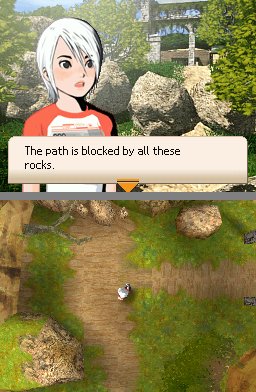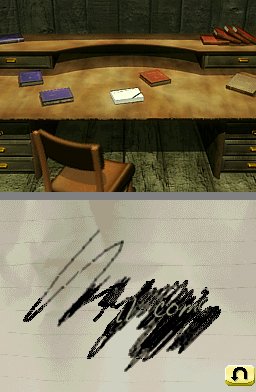Trace Memory Hands-On
We travel the fading paths of memory in this upcoming DS adventure game.
The Nintendo DS is increasingly home to games that take advantage of the system's various unique properties, creating a wealth of intriguing new gameplay experiences. Trace Memory is, on its surface, an adventure game that subscribes to standard conventions of the genre. But by virtue of the fact that it resides on the DS, Trace Memory is able to do some very neat things with its gameplay and puzzle-solving, lending this title a bit of a refreshing edge all its own.

Our heroine is 14-year-old Ashley Mizuki Robbins, who's shipping off to the mysterious Blood Edward Island in search of her father. Having been raised by her aunt from the age of three, she always believed her parents to be dead, until she received a package in the mail one day. Inside was a note from dear old dad and a device (that looks remarkably like a DS) called the Dual Trace System (DTS). She and her aunt Jessica head to the island for a rendezvous as mentioned in the letter, but nothing seems to go as planned. Her father doesn't appear to greet her, her aunt disappears, and in a graveyard she encounters the ghost of a young boy. Called "D," he's been trapped on the island for decades, unable to move on to the afterlife and unable to remember any details of his life or his death. Ashley and D team up to explore their surroundings and the great, old mansion they find, searching for Ashley's aunt and father, while at the same time tracing their own paths of memory to uncover the truth about their traumatic pasts.
You'll move Ashley around on the lower screen of the DS, using either the D pad or the stylus. The top of the screen shows a detailed view of your immediate surroundings. If you can talk to a person who is standing nearby, an icon appears in the bottom screen that you can tap to initiate a conversation. If you can inspect the area you're in, a magnifying-glass icon appears in the bottom screen, which you can tap to get an up-close look. This brings the image from the top screen down to the bottom, where you can tap different areas and items to examine them more closely. You can also use the DTS to take a picture of whatever you're viewing, to save for reference later. In some instances, Ashley will show pictures of important items to characters she meets later on, so it's worth it to snap a shot of stuff you think might be important.
The DTS itself has a range of functions. Besides taking pictures with it, you'll locate various cards scattered throughout the game, containing messages from Ashley's father--either journal entries, or notes left for her directly--which you can read through the DTS. You can also manipulate pictures that you've taken, by rotating them, flipping them, or layering them over another image. Doing so will often net you clues as to how to proceed.
It's an adventure game, so it's predictably heavily puzzle-based, though many of the puzzles have clues scattered about, in the environment and in the dialogue between the characters. While many puzzles are of the "see the hidden picture" or "get the item and then put it in the right spot" sort, there are also a number of them that require use of the DS's features to solve. Without giving too much away, we mean all features of the DS and its dual screens. For instance, at one point in the game, you're presented with a locked door that has a keypad for code entry and some telltale smudges on the window. Think for a minute about how you'd normally get previously traced images to show up on glass--and that's exactly how you'll proceed here. It's definitely a neat twist on normal brainteaser mechanics.

All the images on the top screen of the DS are presented in 2D, while the bottom screen shows character models and environments in simple 3D. The 3D generally looks decent, if a bit on the pixelly side, while the 2D images have really nice detail. Another nice thing is that when you closely examine areas, a lot of times just about every object or region is labeled, so you'll readily click all the regions not only to look for clues, but to possibly trigger any comments from Ashley and D. There's no speech in the game, and there's a short list of tunes that tailor themselves to the various regions of the island and mansion. Sound effects punctuate both interactions with the environment as well as sudden dialogue revelations.
Trace Memory offers up an interesting mystery tale with plenty of revelations along the way, along with some truly unique puzzles that just couldn't be done with any other system. We were truly delighted at some of the puzzles we encountered, though the game itself seemed quite short. Be sure to watch for our full review to see if this game will be able to scratch your adventuring itch. Trace Memory is due on store shelves later this month.
Got a news tip or want to contact us directly? Email news@gamespot.com
Join the conversation